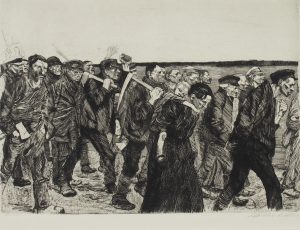16 Narrating artfully
Chantelle Warner

Level:
Intermediate – Advanced
Keywords:
narrative ⧫ past tense ⧫ adjectives ⧫ adverbs ⧫ mood ⧫ setting ⧫ character
Summary:
This lesson was adapted in part from the Narrative Storyboard and activities created around Käthe Kollwitz’s image Weberzug (Weavers on the March), both developed as part of the Art/Write project. The image is part of a cycle, entitled Der Weberaufstand (The Weavers’ Uprising), which was partly inspired by Georg Hauptmann’s play Die Weber (The Weavers) – a dramatization of the 1844 Silesian weavers’ revolt. At the same time, by depicting her figures in contemporary (post-1850s) clothing styles, she also connects the historical events with current day concerns around workers’ rights in the time of rapid industrialization. This historical context might be incredibly relevant for educators who wish to integrate this lesson into a curriculum about that history or in which Hauptmann’s play is an assigned reading, but the activities are designed to be open enough that a focus on Kollwitz’ or another image could be used to explore the linguistic designs involved in narration. By focusing attention on the events, but also the mood and relationships, the lesson pushes students to consider how storytelling – in image or text – can not communicate a series of events but also evoke feelings, through the use of verbs, adjectives, and adverbs.
The activity was designed to be done in the gallery, but could also be adapted in the classroom by posting images on the walls and creating a makeshift gallery, or even for online teaching, by providing digitally-mediated images.
Learning objectives:
- Can describe (with support) a story;
- Can describe or report, what someone experienced, observed, or did with others;
- Can describe (in simple coherent sentences) experiences, events, hopes and goals.
How is a narrative conveyed in pictures?
By definition, a narrative is dynamic. Something must be done. A narrative consists of a series of events. A picture is static. Right? In this activity, we will reflect on the ways in which dynamic events can be conveyed in a static picture.
Tip: The following questions can be discussed as homework, pair activity or in groups.
- How is the tone?
| affirmative | assertive | dismissive | critical | euphemistic |
| ironic | approving | neutral | sarcastic | e.t.c. |
- What effect does the picture have on you?
- How is the setting? Which words do you need to describe the environment?
- Who are the characters? How old are they? Which facial expressions are represented? What are they wearing? How is their posture? What genders do the characters seem to present? Which social class do the characters seem to present?
- How do the characters interact with each other?
- Which feelings do the characters show? Why do you think so? How is the visual portrayed?
- What is happening? How is the visual portrayed?
How is a story composed (in writing)?
Write an appropriate story for the picture. Use your imagination for the tone, the setting, the characters, and the events from the first activity. However, the story needs to include additional characters and events not portrayed in the picture.
Use the storyboard below to organize your story. Insert new lines where necessary.
| Picture | Narrative moments | What is happening? (Answer the questions on the left.) |
| Begin with the picture. | Orientation.
Who? What? When? Where? |
|
| Draw what happens next | Complication
And what has happened next? |
|
| Draw what happens in the end. | Resolution
What happened in the end? |
Summarize your story in 5-7 sentences.
Same picture, different perspectives?
Compare your story with the stories of your classmates.
Which similarities do you notice? Which differences do you notice?

